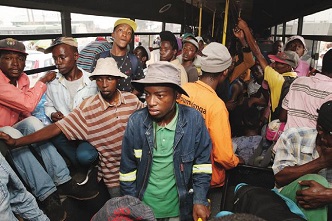Department of Social Development 2021/06/28 - 22:00

As the world marks International Day Against Drugs and Illicit Trading on the 26 of June annually, substance abuse remains an enormous social problem in South Africa, as elsewhere in the world.
Substance abuse is defined by Hilton, Betancourt, Morrell, Lee, and Donkey (2018: 510) as taking drugs that are not legal but further that, they define substance abuse as taking alcohol, prescription medicine, and other legal substances too much or in the wrong way.
The World Health Organisation (WHO) defines substance abuse as the harmful or hazardous use of psychoactive substances, including alcohol and illicit drugs.
South Africa has been reported as a country that is experiencing high levels of alcohol abuse. WHO provided the international statistics of alcohol consumption across 194 countries. The study was based on the per capita use of alcohol in South Africa.11.5 litres per capita per year was reported in 2015 which is higher than the 11.0 litres consumption of 2014. In 2015, SA was ranked as the third biggest drinking nation in Africa and ranked number 19th biggest drinking nation in the world.
Alcohol consumption in the country is double the average of 6 litres consumption regulated by the World Health Organisation. Alcohol is the most common substance of abuse among the adult population in the country. Although a relatively low proportion of South Africans report drinking alcohol (27,9%), those who do often drink at harmful or hazardous levels, particularly on weekends they are estimated to be about 2 million people that could be classified as problem drinkers.
The socio-economic cost of alcohol abuse was estimated to be R130 billion per year. It is also estimated that more than 7000 people perish every year due to alcohol. So naturally if you have adults that abuse alcohol this has translated into young people who drink like them. Despite these reports, South Africans still do not see alcohol abuse as a problem. They are willing to confront the abuse of illicit drugs such as cannabis, cocaine, nyaope and tik as demonstrated during the Youth Day, June 16 commemoration by the community of Diepkloof in Soweto who marched to the houses of alleged drug peddlers.
Yet, statistics showed that alcohol abuse is the most abused substance in the country followed by those taking illicit drugs. It is reported that fellow countrymen take of alcohol is twice as much as compared to other nations of the world. A study by the Central Drug Authority (CDA) found that the high consumption and abuse of alcohol in the country was common among young people. Drug dealers targeted schools and drugs were disguised as lip balms, tattoos and lollipops.
Former drug dealers interviewed claimed to make as much as R18 000 per day and a dependent could spend an average of R5 000 per day. Unemployment, lack of effective mentorship, lack of family values, poor parenting guidance, and loss of hope contributed are some of factors attributed to drug abuse.
International research showed that substance abuse amongst women occurred for different reasons than men, women were drawn to substance abuse out of loneliness while men were likely to abuse drugs or alcohol to gain group acceptance. Consequently, women required a different treatment programme and one that provided child care. It is estimated that 46% of women were dependent on drugs and are likely to be victims of rape and physical abuse and were also more likely to be victims of incest.
Historically, treatment centres had catered primarily for men. Centres for women needed to have childcare
facilities and provide support for mothers for the duration of the treatment period, which could last up to 90 days. Some of the interventions identified by the people during the survey conducted by the CDA felt that parents needed support and help to be better parents.Parental guidance was needed as the Gauteng Department of Social Development and civil society involved in the sector reached out to communities through the rollout of the drug master plan. The department also continues to provide support services to drug addicts and their families. There are about 80 treatment centres in the country and these could treat 20 000 a year, but the demand is nine to 15 times more.
Drug Rehabilitation Centres are not a solution to drug abuse according to the Central Drug Authority - 1/3 of people who become dependent become sober and stay that way, 1/3 relapsed one or more times, and 1/3 relapsed continually. What was needed was long term treatment, a change in attitude and the involvement of everyone.
There is also a need to standardize the legislation to regulate the sale of alcohol and the Department of Trade and Industry is looking into the rezoning of taverns. Operating hours of taverns should be reduced as taverns have been identified as an entry point to both alcohol and drugs.
What is of concern is most people are not worried by the health risks associated with drug use and abuse. Furthermore, there is a concern at the breakdown of society; people are under pressure and drugs are a means of escape.
There is a need for greater law enforcement as demonstrated by the Hawks recently where alleged international syndicates were arrested and huge quantities of illicit drugs seized. The drug business was the second most profitable business in the world, after arms. The people running the business were relentless in their effort to sell their product.
Research has shown that, where there had been success in addressing the problem, the culture of communities had changed. In French households drinking was acceptable but being drunk was unacceptable, and so there needs to be a shift in what communities find acceptable behaviour.
RELATED NEWS
No related news

